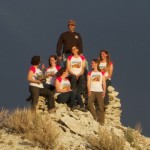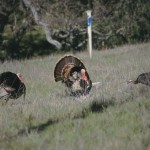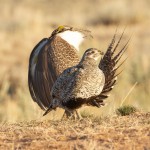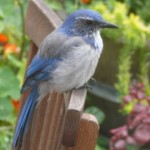Jessica Blickley’s Conservation Biology paper on the impact of chronic anthropogenic noise on sage-grouse took over 18 months to go through review. Thankfully our more recent paper proceeded much more quickly, in fact, it just came out. May I present: Experimental Chronic Noise Is Related to Elevated Fecal Corticosteroid Metabolites in Lekking Male Greater Sage-Grouse (Centrocercus urophasianus). This is in the journal PLoS One (PLoS = Public Library of Science, one of the first Open Access journals that charge a bit more for publishing but make the content freely available to everyone). The paper asks whether we can detect differences in traces of stress hormones in the poop of grouse that were on leks exposed to chronic noise versus control leks without the extra noise. The answer is yes, but like many things in science, the answer becomes a bit more complicated when you look at the details, or try to figure out what the results you find actually mean. There was a difference in the average level of corticosterone metabolites, but this wasn’t diagnostic. Additionally, it didn’t matter how close to the speakers the poop (and presumably the males) was, so the differences were shared across the entire lek. Still, further evidence that noise impacts are serious business for birds like sage-grouse, and are something management plans may want to take into account.
Jessica has another paper that just came out- this as the product of a seminar she took a couple of years ago. She and her colleagues put together a survey of job ads and questionnaires of people in charge of hiring conservation professionals- both to try to decode what skills ads are really asking for, and also to identify skills that graduate students might not get in the course of a “normal” PhD (whatever that is). It should be a really useful paper, and I’ll be sure to add it to one of the resources pages here next time I update those. So check out: Graduate Student’s Guide to Necessary Skills for Nonacademic Conservation Careers in Conservation Biology.
We’ve made some progress on several other fronts as well. We’ve gotten several other papers submitted, including a detailed look at fighting dynamics in male sage-grouse that I believe is our first paper making use of the high-speed video of male behavior. Another project we’ve gotten off of our desks is a characterization of the mechanical sounds in the sage-grouse, lead-authored by former undergrad and technician Becca Koch (now in a PhD program at Auburn). Gail and I also contributed to a paper on the negative effects of necklace-style transmitters in male-sage-grouse that included the acoustic analysis of one collared male with odd sounding displays. We have a few other manuscripts perched like baby birds at the nest hole, waiting to take that brave leap into the wide world of academic publishing. We should have at least one more paper make that leap before the end of the year. Big thanks to Gail for using much of her sabbatical to contend with some of this.
In other news, teaching is still the big focus, although I can’t believe how quickly it has gone. Only 4 more lectures in the quarter! I’m done with my other lectures for the time being (my City College of San Francisco seminar was on the previous Friday), but I’ve got several lectures, seminars, and meetings lined up for early in the new year including.




